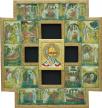Markovych, Roman
Roman Markovych is a contemporary iconographer whose art is an extension of the Ukrainian icon painting tradition. The work is executed in the traditional technique of levkas, as well as oil on paper.
Born in 1961 in Ukraine , Markovych received his academic training at the prestigious Lviv Academy of Art, graduating with an M.F.A. degree in 1984. He now lives and works in Stamford, Connecticut, specializing in icon and mural restoration.
In every nation’s history, the artistic tradition is tightly intertwined with the nation’s spiritual and philosophical heritage. Art is undoubtedly the most enduring means of expression of all the aspects of a nation’s life. Since its inception in ancient times, art was always closely linked with religious belief and the natural environment. Thus fine art came to serve a part in the life of each member of the community, in the forms of sculpture, architecture, ornamental art, and religious iconography. This equally holds true for Christianity, Buddhism, Islam, and other world religions.
We are pleased to offer the public the artworks that belong to the tradition of Eastern Christian icon painting, or “iconography” in its original meaning—a medium of painting and all its visual systems. This is the dominant art form of the Medieval state of Kyivan Rus (predecessor of modern Ukraine ), from the time of conversion to Christianity in 988 onward. This tradition was carried on in Ukraine through the Renaissance era and up to the present time. Even though icon painting first and foremost served the needs of the Church, just like other art forms, it is profoundly linked to the world around us and this world’s material and emotional components.
Rich in symbolism, the Eastern Slavic iconographic tradition is a repository of edificatory tales, capturing our interest with a broad range of themes ranging from the lyrical to the tragic. This art captures the nation’s poetic perception of the world, its original approaches and profound artistic beauty. It elevates the viewer, impacting our perceptions and values.
Coming in contact with these works, the viewer is invited to an excursion into the world of the artists of olden days who tried to evoke and transmit these perceptions and values to all people. These icons will leave you fascinated with the daily life of a bygone era, but also with a profound spiritual and moral impact.
The rich and diverse cultural heritage of the United States links this country to a wide range of spiritual and creative traditions. Experiencing the living legacy of icon painting, an integral part of Ukrainian artistic, cultural, and historical traditions, will help build mutual understanding between our nations.
* * *
It is impossible to comprehend fully the Ukrainian artistic tradition if one bypasses the great creative legacy of the ancient state of Kyivan Rus that became a firm foundation for the nation’s artistic culture. The icon, as a genre of painting and as an artistic system of images, was brought to Kyivan Rus (predecessor of modern Ukraine ) from Byzantium with the conversion to Christianity. The young state eagerly absorbed the traditions of Byzantine culture and aesthetics, and through them to the entire artistic tradition of the Hellenistic world. Thanks to this, the artists of old Rus turned first and foremost to the image of a human being, which became the main them of artistic practice of the masters of that era. And although icon painting was fully subordinate to the needs of religion, in it, as in any form of visual art, we find the representation of the material and emotional spheres of real existence. The depiction of religious motifs follows established canons; the master should be concerned not with representing concrete impressions of the world around us, but with creating ideal images and saturating them with particular spiritual emotions and values.
The icon as a form of easel painting is characterized by certain technological peculiarities. In Rus (and Ukraine), the icons were mostly painted on board of linden wood, held together with glue and with special fastening clamps on the edges. On the front side, the main image was placed at the center, surrounded by borders. A special fabric, known as pavoloka, was glued onto the board to strengthen the binding with the special plaster- or chalk-based primer, known as the levkas; over the primer, the artist painted with egg tempera.
SUGGESTED READING:
Hryhorii Lohvyn, Vira Miliaieva, Vira Svientsytska, Ukrainian Medieval Painting (Kyiv: Mystetstvo, 1976)
Masterpieces of Ukrainian Icon Paining, 12 th—19 th Cc., ed. by Larysa Chlenova, intro. by Mykhailo Romanyshyn (Kyiv: Mystetstvo, 1999)
Volodymyr Ovsiichuk, Ukraïnske maliarstvo X–XVIII st. [Ukrainian painting of the 10 th—18 th cc.] (Lviv: Ethnography Institute of the National Academy of Sciences of Ukraine, 1996) [summary in English]












